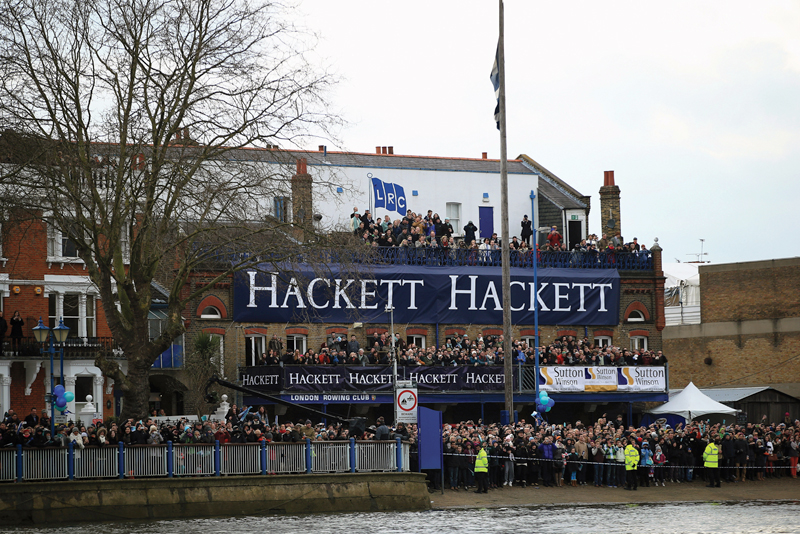In recent years, he searched for and found his mother and his father whose identity his mother had kept from him. “She said to me: ‘I let my guard down.’ I sort of knew he was probably American. I got word that my half brothers and sisters were in Australia and I was headed out there for business and I thought why not, don’t put it off and found myself surrounded by them – and they all looked like me.” Later, he would go to America to meet his father. “So now I have 11 half brothers and sisters!”
In his late teens he left Bristol and headed for London. “I had been going back and forth, trying to bring London things to Bristol but soon realized that I should be there, where things were happening. I used to travel across the UK, head up to Scotland – we were selling second-hand clothes then – and try and pick up some tweeds. But the pickings were thin so we started making our own clothes.”
Hackett has gone from second-hand clothing to a worldwide fashion business. Most successful businessmen and women can pinpoint a moment or two that inspired them to greater heights. “I don’t know about inspiration, we just did the next thing. We closed the shops in Fulham and found this place.” ‘This place’ is 137/138 Sloane Street on the corner of very chic Sloane Square. “There were three little shops and we knocked them into one. The way we always did things was to just do it, even though we didn’t really have the money.”
Take one step inside Hackett’s flagship store and you would get the impression that this is some ancient family store. Hackett smiled, genuinely bemused. “People think we’ve been around for ages. It’s only 30 years.” The impression is strengthened by the bespoke tailor’s department on the second floor (where you can also get your shoes polished old school) and the barber’s on the third floor. The barber’s is like bread and milk in supermarkets – always put it as far away as possible so the customers have to go through the rest of the place to get there. “I’ve seen men come in for a twenty quid haircut and leave having been fitted for a new suit.”
Hackett is constantly checking people out, commenting on what they’re wearing. Does he think about fashion all the time? “Yes, all the time.”
Ronnie, the driver assigned to take us to the Boat Race, took us past that first shop in Fulham. “I used to shop there,” he said. “All second hand clothes – it was cool, we were cool.”
Parked outside the London Rowing Club, which Hackett also sponsors and where he entertains during the event, an Aston Martin DB9 is parked. Neil Bugler, Hackett London’s Sponsorship Manager, is looking after it (Hackett: “They wouldn’t let me drive it.”). Aston Martin is another partner in the company’s sporting portfolio. Bugler has been with Hackett for 20 years and runs the sponsorship side of things. “That first shop used to get burgled regularly by kids from the high rises. They didn’t get much but those curious porthole windows were listed and had to be replaced, which cost a packet.
“Sport’s important as part of our image. The boat race was such an easy fit, really. Likewise Aston Martin and our polo sponsorship.” Hackett provides both rowing crews with formal wear and fleeces and jackets. The ‘Battle of the Blues’ range bears the crests of Oxford and Cambridge Rowing Clubs and includes rugby shirts, polo shirts, sweat shirts and T-shirts, all available in Hackett stores and online.
Men’s Health said of Hacket t’s book Mr Classic: “For the man of 2008 who can see that the devil is in the detail, this book is indispensable.” As the photographer took his publicity shots on the terrace overlooking the Thames, Hackett donned a natty yellow scarf and asked: “Did you spot the rowing tie-pin?”
He really does have an eye for detail. An old painting hangs in the London Rowing Club dining room and he wants to use a detail from it for a one-off shirt. It’s a rowing picture from the turn of the last century. He points out a young rower, standing hands on hips admiring the others in the water. Hackett has spotted the scarf that gives the young man an air of timelessness.
As the crowds gather and the water level (and the anticipation) rose, Hackett headed down among the revelers, ten-deep now by the riverbank, his camera at the ready. To take photographs of the race, no, rather of the people and, even more specifically, the clothes on their backs.
www.hackett.com







